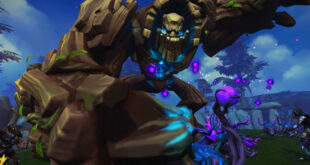HUEBRIX, the third game from Mumbai-based Yellow Monkey Studios, is set for release today.
The four-member team – Shailesh Prabhu (founder and game designer), Krishna Israney (game designer), Manu Thomas (game programmer) and Yorrick Mendes (game Programmer) – spoke to MCV about the new game, the journey so far, and the challenges facing indie game developers in India.
Was Yellow Monkey always intended to be a mobile games developer?
Shailesh Prabhu: Not really. We tried our hand at Nintendo DS development. We spent a year of pre-production for a point-and-click adventure called Motley. It was a humorous, graphical point-and-click adventure. Manu had made a small demo which we pitched to a lot of publishers. We got a good response from publishers, but these were mostly the smaller publishers, so they weren’t willing to fund. They wanted us to finish the game and they’d handle the marketing. That was tricky for us because completing that project meant that it would take at least Rs 30-40 lakhs. The cost of dev kits itself was $5,000. We simply didn’t have the resources for that. We tried to go the funding route but that was never going to work because people would just start dictating terms.
The iOS App Store was just opening up around that time, so we thought we’d try and get some games on there; games that were more manageable just to start us off. We got this US-based client, who was primarily interested in marketing and promotion if someone wanted to develop for them. We started off with that and we were breaking even. We created a team and got into services in a big way and started working with a few other clients as well, but we realised that all we were doing was services and that wasn’t going anywhere. Once you start down that path, all your time is spent satisfying the client, getting things right, getting new clients, and scaling up to meet their demands. This becomes a cycle and a business of its own, and we realised that this was not a route we wanted to take.
We want to focus more on our own games, and that has helped us stay afloat, actually. What has helped even more is that we operate on the basis of revenue sharing. We don’t have a salary structure. That also keeps those working on the game motivated; it’s their product and they own it as much as anyone else working on it.
How long have you been working on HUEBRIX?
Shailesh: We released our first game, Finger Footie, in June 2010, and the second game, It’s Just a Thought, in December 2010. Then we did some project work, and came back to start on HUEBRIX. So we started work on this game in April 2011. That’s when we started brainstorming and prototyping, and it was a completely different game back then. So we’ve spent almost a full year on it.
Yellow Monkey Studios (L to R):Manu Thomas, Yorrick Mendes, Krishna Israney,Shailesh Prabhu
How do you decide on what sort of game you’re going to make? Do you make the kind of game you’d want to play or do you try to do something that hasn’t already been done?
Shailesh: The thinking behind all the three games we’ve worked on has been different. For Finger Footie, we wanted to do something different around football, because back then, most of the football games used virtual console controls. We thought that was a clumsy approach, so wanted to make something more intuitive and touch-driven. At that time, I don’t think there were any touch-based football games on the App Store. Now, of course, there are plenty.
With It’s just a thought, we just wanted to get noticed. We wanted to do something that would at least get the attention of the indies and the festival guys; just so people would know that we exist. We thought that it could be a way for us to start building some sort of following. So we decided that even if we didn’t make any money off this game, it was fine as long as it gets us some eyeballs.
With HUEBRIX, we have a team, but we don’t have an artist. Krishna is the closest we’ve got, but he’s not a trained artist.
Krishna Israney: We don’t have the sort of artistic talent we’d need to compete on the global level. So we restricted ourselves to the extent of what we could do, and focussed on making sure it was polished.
Shailesh: With HUEBRIX, we wanted to make a game with little or no art; a game that doesn’t need an artist. The obvious choice was to go with a puzzle game. We looked at Sudoku, with its use of squares and numbers, and asked ourselves, ‘Can we make a game like that?’ It’s not like there’s no art at all. I think we’ve done quite well considering we don’t have an artist. We did add a bit of art, but it’s something we added later because we thought the game deserved it.
Krishna: At one point, we even felt that it deserved us bringing on an artist and incorporating characters into the game. In fact, our first prototype involved worms gobbling up jawbreakers, and we had incorporated some whacky animations too. But we found that the game didn’t work with a casual art style due to the inclusion of numbers. The casual art style would make it look like a game you could easily breeze through without requiring too much thought. But this is not that sort of game. So after spending about two months trying to create a character-based art style, we decided to roll it back.
Shailesh: It just wasn’t working. With that kind of art it was neither appealing to the people who like games like Cut the Rope, nor was it appealing to those who like puzzle games. There was too much happening and it was distracting from the core mechanics.
Krishna: So what we’ve now done is given the audience that we’re expecting for this game the kind of art that they would expect.
Shailesh: We’ve catered to that specific audience, so now we’re hoping that audience is big enough and they’re ready to play this.
Do you have plans for post-release support? More levels, perhaps?
Shailesh: We do have plans, but that all depends on the reception the game gets. But yes, we do plan to support the game for a significant amount of time. We have a new game mode that we can introduce that can actually be a game in itself, but if the game is well received, we would like to give it to the players as an added bonus for playing the game. There’s also a level editor that comes built into the game, so players can create their own puzzles and share them with friends.
Guest column: The Pursuit of IP-ness
This is the first time you’re releasing one of your games on Android. Will the iOS and Android releases be simultaneous?
Shailesh: Android and iOS versions will both be released together. A browser version will also be released simultaneously. We’re working on a Mac App version as well, but that will be delayed a bit. The Flash version will be more of a promotional version and it won’t have all the levels that are included in the paid mobile versions. It’s more like an advertisement or a sampler.
Did you guys always want to self-publish your games or are you open to tying up with publishers?
Shailesh: We’re open to the publishing model, but to be honest, we don’t know which publisher really adds value in today’s day and age. There are very few who really know their way around the App Store. A lot of them are just playing the numbers game, where they’ll publish 100 games and one of them will do well. If your game isn’t one of those games that they’re focussing on, you’re just lost in the crowd.
It is harder now though for indies to stand out in the crowded app stores.
Shailesh: It’s always been hard for indies to stand out, I think. Indie marketing is more about marketing the developer than the game. If they care about us, they’ll care about our game. I’m not saying that they don’t care about the game, but I think what has worked in indie marketing is putting the developer in front of the audience before the game. That’s a chicken and egg situation too, because no one will care about us if we don’t have a decent game out there.
That’s quite the case in India though, isn’t it? We all know the developers, but we don’t really know the games they’ve made.
Shailesh: That’s true. Also, it’s not a very good thing to say, but at some level, I don’t know if the global games community thinks that Indian game developers can come up with something original and fun. I think the general perception is that India is good for cheap labour. So we’re putting ourselves out there and hopefully there will be takers.
Since you guys are self-funded, how do you manage to sustain yourselves while you work on a game? Do you take up other projects on the side?
Shailesh: For HUEBRIX, we took up a bunch of projects in the beginning and we also won a cash prize for It’s Just a Thought (Best Original Idea award at hoPlay 2011), so that helped us come up with a decent amount of money to get through the development phase of HUEBRIX. That’s running out now though, and we’ve actually fallen short of funds for marketing and advertising on this game.
Krishna: We tend to balance out the workload when we take up projects, so while one or two of us might move to a project, the rest of us will still be working on our game.
Shailesh: This method actually stretches the life cycle for our game, but it helps ensure that we’re able to see it through to the end.
You mentioned that Western audiences don’t seem to think Indian developers can make good games. But it is a fact that we haven’t seen too many high quality original games come out of India. Why do you think that is?
Shailesh: I think it’s always been a question of polish. I think all of the games that come out of India, whether or not they have good gameplay, none of them are polished. At least that’s my view. Even our own games – we didn’t polish Finger Footie as much as we should have. In a lot of the games you see out there from Indian devs as well as from devs of other countries that you wouldn’t normally associate with game development, the problem is mainly a lack of polish.
Polish aside, you don’t see too many original IP either coming out of Indian studios.
Shailesh: I think a lot of Indian game developers are working on client-based projects for clients who themselves don’t know what they want, and that leads to mediocre products. I won’t say that Indian developers don’t have good ideas. I’m sure some of them do, but it’s more a question of acting on those ideas.
HUEBRIX
So is it the unwillingness to take risks?
Shailesh: I think so. I’m not here saying, ‘We’ve arrived!’ We’re still taking risks and we don’t know how HUEBRIX will do, but I think more people who want to make games should be taking these risks. Otherwise you’re just doing someone else’s work; someone needs a game made and you’re making it for them.
Krishna: I also think that in India, we don’t give enough time for ideas to develop. For HUEBRIX, it was only 3-4 months into development that we knew what this game was going to be about. This is not the game that we had initially planned.
Shailesh: We didn’t even know that HUEBRIX was the game that would eventually get made; it was just one of a few ideas we were toying with. It was about six months into development that we felt like we had a game here. This an important phase of development, where all ideas need to be exhausted before moving into full production. A lot of developers don’t give their games that time.
Also worth mentioning is that a lot of people are not okay with cancelling projects. They feel like, ‘We’ve created a prototype, so let’s get it out there’. But if it’s not good enough, you probably shouldn’t put it out. In fact, we recently scrapped a project. It’s a concept that works and it could be a good game someday, but it’s something we can’t manage at this time. So we’ve scrapped it, and I think more developers should be okay to scrap games for whatever reason – if it’s not good enough, if they can’t do justice to it.
Do you know what you guys are going to work on once HUEBRIX is out?
Shailesh: Not really. We do have a few ideas
Krishna: We actually have a couple of games pending. One of them is a running game and we’ve got a bit of work to do on the gameply front. That one will be a little easier to complete because there are already so many running games out there and we know what we’re aiming for. It’s not something very new that we’re trying to accomplish. Other than that, there’s nothing new that we’ve thought of yet.
Shailesh: HUEBRIX and It’s Just a Thought are games that didn’t have precedents. Even though HUEBRIX is a grid-based puzzle game, it’s unlike any other out there. So when you’re doing something that doesn’t conform to something that’s already out there, it takes a lot longer. You have to figure out what people will expect and what they will intuitively know and won’t know. That’s what’s taken us so long; getting these nitty-gritties right.
Are you satisfied with the platforms you’re currently working on or are there some ideas that you think you can’t execute on mobile platforms?
Shailesh: As of now, we’ve accepted that we’re on this (mobile) platform and we’ve worked backwards from there. So right now, we’re trying to make the games that can do well on this platform. We have ideas that are more suitable for higher end consoles, and tech-wise I’m sure that we can handle that, but it’s not like we’re unhappy with the mobile platform. There’s a lot more that we can still do on mobile.
Sign up for the free MCV India newsletterhere.

 MCV/DEVELOP News, events, research and jobs from the games industry
MCV/DEVELOP News, events, research and jobs from the games industry



